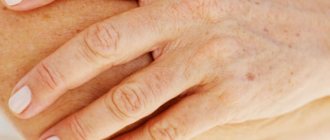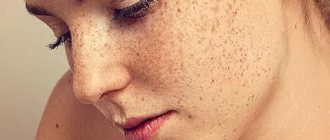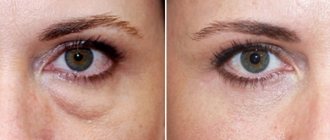Home / Articles / Why do small age spots appear on the legs?
Any changes in skin pigmentation require consultation with a specialist. The appearance of dark formations on the body can be a sign of cancer, metabolic disorders, or allergies. Depending on the reasons, treatment can be carried out by a dermatologist, cosmetologist, oncologist, endocrinologist and other doctors. But if small pigment spots appear on your legs and arms, you should start your examination by contacting a therapist. He will examine the lesions, develop a diagnostic program, and refer you to other specialists according to indications.
Causes of Melasma Pigment Spots
Reason number 1 is ultraviolet rays. They stimulate the production of the hormone melanocrine, which activates the work of pigment cells.
Normally, a tan appears on the skin, but if there are other provoking factors, or an increased dose of UV rays, spots appear.
Clinical observations have proven that high intensity of visible light (sun, energy-saving lamps, computer and smartphone screens) increases the intensity of pigmentation in people prone to its formation.
- Pregnancy and lactation
- Taking hormonal medications, including oral contraceptives
- Endocrine system diseases
- Genetic predisposition
- Medicines or external agents with a photosensitizing effect
A study conducted on 324 women with pigment spots showed that the onset, protracted course and reappearance of pigmentation occurs when the main trigger factors are combined. Namely: pregnancy, prolonged exposure to the sun, age, taking hormonal contraceptives, genetic predisposition.
Table of contents
- Etiology and pathogenesis
- Clinical manifestations
- Principles of treatment and hardware correction
Hyperpigmentation (dyschromia, darkening of the skin) is a condition in which certain areas of the face and/or body become darker than the surrounding skin under the influence of various factors.
In our company you can purchase the following equipment for removing hyperpigmentation:
- M22 (Lumenis)
- AcuPulse (Lumenis)
- Fraxel (Solta Medical)
- UltraPulse (Lumenis)
How to lighten pigment spots with melasma
- Provide skin protection from excess exposure to ultraviolet rays and blue light. UV rays and visible light rays are the main trigger for the appearance and recurrence of pigmentation. Their use is mandatory, regardless of the time of year.
- Lightening agents that help:
- decreased division of melanocyte pigment cells
- suppression of pigment formation inside melanocytes
- destruction of formed melanosomes
Those. a full range of effects on the mechanisms of melasma.
The Latin American Academy of Pigmentary Disorders Academy-PDA has developed an algorithm for selecting therapy depending on the degree of its development:
- Mild degree - use of drugs based on Azelaic acid up to 20%
- Moderate and severe degrees - only combination therapy, including several ingredients with a brightening effect, with different mechanisms of action.
What should be included in the combination drugs, see below.
Etiology and pathogenesis of skin hyperpigmentation
One of the most common causes of hyperpigmentation is ultraviolet radiation. As a result of prolonged and/or frequent exposure to the open sun, as well as with regular visits to solariums, melanocytes begin to intensively produce pigment, which is deposited in the skin and causes its darkening. Interestingly, after 30 years, the number of melanocytes in the skin decreases by an average of 6-10% every 10 years. However, in tanned areas, their number, on the contrary, increases - this increases the risk of hyperpigmentation in areas of habitual tanning.
Skin hyperpigmentation can occur as a result of environmental pollution ( pollution ). This problem is relevant today for all people living in large cities and metropolitan areas. Urban smog particulates with a diameter of 2.5–10 microns (PM2.5–10) easily penetrate the skin and can accumulate in it, creating dark areas. In addition, under their influence, genes responsible for the formation of age spots and premature aging of the skin are activated in keratinocytes.
Not the least role in the appearance of hyperpigmentation is played by hormonal changes associated with pregnancy, menopause, taking oral contraceptives and other medications. Most often, darkening of the skin is caused by an increase in estrogen, melanocyte-stimulating hormone, progesterone, or an increase in the number of receptors for them in cells.
Hyperpigmentation of the skin of the face and body can be a consequence of various diseases - both congenital and acquired. For example, flat, café-au-lait pigmented spots on the skin with clear boundaries and usually irregular shape are a hallmark of neurofibromatosis type I (Recklinghausen's disease).
Genetic predisposition plays a certain role - the hereditary mechanism is responsible for the occurrence of ephelides (freckles). Darkening of the skin often occurs as a result of an inflammatory process (so-called post-inflammatory hyperpigmentation) - for example, after acne.
From a practical point of view, the following is important for a cosmetologist and clinician:
- melanin synthesis is carried out in the cytoplasm of the melanocyte from tyrosine;
- its first two stages involve tyrosinase (which is most often the target of bleaching agents).
After melanin synthesis is completed, it is loaded into transport melanosomes and moves along the long processes of melanocytes to keratinocytes. Therefore, another way to reduce pigmentation is to disrupt the formation of melanosomes and/or their transport along the processes.
What groups of ingredients are used to lighten skin?
Representatives of these groups should be sought in the compositions of combination drugs.
- Tyrosinase inhibitors – azelaic acid, arbutin, flavonoids, resveratrol .
- Destruction and reduction of melanosomes: niacinamide, soy extracts .
- Inhibition of DOPA and dopaquinone synthesis: kojic acid.
- Exfoliation of the stratum corneum: AHAs and retinoids.
- Stimulation of the conversion of melanin to leukomelanin: vitamin C, E and glabridin.
Summary : to effectively lighten pigmentation and reduce the likelihood of side effects, it is more advisable to use combined preparations containing ingredients from different groups.
Clinical manifestations of hyperpigmentation
The main types of skin hyperpigmentation according to clinical manifestations:
- Ephelides (freckles) are small spots of light or dark yellow color, usually localized on the face ( Fig. 1 ).
- Melasma (chloasma) is blurry spots on the face, usually arising against the background of hormonal changes ( Fig. 2 ).
- Solar elastosis is an uneven icteric hyperpigmentation with thickening of the skin, the presence of dynamic or static wrinkles.
- Solar purpura is uneven, intense hyperpigmentation with telangiectasia and wrinkles.
- Post-traumatic (secondary) hyperpigmentation - dark spots that have a slight bluish tint in the first weeks after appearance, which form at the site of skin trauma.
- Post-inflammatory hyperpigmentation of the skin of the face and body is local darkening that occurs at the site of inflammation.
- Systemic hyperpigmentation is skin coloring as a result of a disease (for example, adrenal disease).
It should also be mentioned that, based on the depth of the pigment, there are 3 types of hyperpigmentation: epidermal, dermal and mixed. This is important from the point of view of further choice of treatment tactics.
Rice. 1. Freckles (Danish national service on dermato-venereology)
https://www.danderm-pdv.is.kkh.dk/atlas/7-128.html
Rice . 2. Melasma (Danish national service on dermato-venereology)
https://www.danderm-pdv.is.kkh.dk/atlas/4-161-1.html
Basic questions about spider veins
- Is it painful to remove spider veins on the legs?
This question worries all women who decide to get rid of spider veins on the skin. The answer is very simple. For microsclerotherapy, the finest needles are used, so the injections are so painless that they surprise everyone who has undergone microsclerotherapy. In addition, our clinics use a cryosclerotherapy protocol. We always cool the skin with a special cooler, which makes injections absolutely painless. Treating intradermal vessels in the legs with laser or RFO is more difficult than with cryosclerotherapy and more expensive for the patient. Spider vein sclerotherapy is a painless and well-tolerated treatment procedure.
- What time of year is best for treatment?
It must be taken into account that the process of disappearance of the venous network after a course of sclerotherapy takes approximately two months. Therefore, if you are planning a vacation, then expect that you will be able to enjoy clear, star-free skin approximately 2-3 months after completing the course of treatment. Plan your visit to the phlebologist in advance so as not to be disappointed during your beach holiday. Treatment should not be done during pregnancy and breastfeeding, since the effect of the sclerosing drug on the child is unknown.
Principles of treatment
Deep pigmentation does not respond well to external treatment methods, since the pigment lies quite deep in the skin - and it is extremely difficult to influence it from the outside. Whitening agents such as hydroquinone, tranexamic or azelaic acid can have a certain effect in some conditions (for example, melasma). There is evidence of the benefits of chemical peels, but you should be extremely careful not to cause even more pigmentation in the treated area.
Deep pigmentation is successfully treated with hardware methods - intense pulsed light (IPL) and lasers. The operating principle IPL therapy is based on selective photothermolysis - the absorption of light radiation energy by melanin with the subsequent destruction of unwanted pigment. For more precise exposure and prevention of heating of the surrounding skin, the IPL module of the M22 device from Lumenis uses a set of light filters. Each of these filters cuts off the wavelength range most suitable for a certain pigment depth and phototype.
If the pigment lies very deep, intense pulsed light may not be effective enough - in this case, non-ablative fractional photothermolysis is recommended Fraxel and M 22 ResurFX devices . Fraxel includes a 1550 nm erbium laser to work at the dermal level up to 1400 µm (1.4 mm) deep, as well as a 1927 nm thulium laser to work at the epidermal level up to 210 µm (0.21 mm). ResurFX uses one wavelength - 1565 nm, but this module can be combined in the M22 device with an IPL module and an Nd:YAG Q-Switched laser, so you can successfully treat any form of pigmentation.
Non-ablative fractional photothermolysis is based on the creation of microthermal treatment zones in the skin - tiny foci of thermal damage, between which there are intact (untouched) areas. This allows not only to effectively destroy unwanted pigment, but also accelerates subsequent skin restoration, because cells from intact areas migrate to microzones of damage. Non-ablative fractional photothermolysis is the method of choice in patients with skin phototypes IV–VI, who can undergo IPL therapy with restrictions.
Questions from our users:
- deep skin pigmentation on the hands
- deep skin pigmentation on the hands treatment
- deep skin pigmentation laser removal
- age-related deep skin pigmentation
Preventive measures
By adhering to certain rules, the likelihood of pigmentation occurring in the leg area is reduced to zero.
- Do not stay in the hot rays of the scorching sun for a long time.
- Protect your legs from direct sunlight with trousers; thick fabric can shield the body.
- Drink as much fluid as possible to prevent dehydration.
- Add as many fruits, vegetables and herbs (parsley, celery, dill) to your diet.
- When preparing breakfast, lunch or dinner, do not forget about vitamin E, which is abundant in butter.
- Buy cosmetics with a whitening effect and high quality, do not skimp on the price.
- For pigmentation, apply masks and cream compositions to the skin in winter (late autumn, winter).
- When you decide to sunbathe on the beach, do not forget to use sunscreen. It will protect the skin from the occurrence of pigmented, brown spots.
- The skin, which was previously subject to pigmentation, becomes sensitive. Protect your feet from exposure to ultraviolet radiation.
Formation of pathology with varicose veins
Varicose veins are a serious disease that causes pain in the legs and then in the heart. Varicose veins are not a fatal disease; they can lead to serious complications: thrombophlebitis or trophic ulcers, which lead to death.
At the first symptoms of the development of varicose veins, swelling of the limbs appears, which quickly passes. But over time, the swelling areas begin to itch very much, and pigmentation appears.
It has a smooth, shiny appearance, sometimes covered with small blisters, which pass from time to time and then reappear. Without timely treatment, the disease begins to progress.
The itching and burning of damaged areas increases significantly. Light spots take on a dark brown tint. Their formation occurs due to blood stagnation.
The spots are quite dangerous and appear in the ankle area. They lead to varicose dermatitis and create scarring wounds.
If treatment is not carried out, the skin where the spots appeared becomes dense and dry, and cannot be folded. After some hour, liquid appears, which indicates a trophic ulcer.
Before you begin treating varicose spots, it is necessary to cure the underlying disease. In order for the skin to acquire a natural color, blood vessels should be treated.
If there are bulging veins, it is impossible to remove pigmentation!
The disease is treated and diagnosed by a surgeon and a dermatologist.
Experts prescribe:
- Diet therapy;
- Wearing special underwear;
- Ointments and gels;
- Therapeutic exercises;
- Electrical stimulation, it improves blood movement to the extremities;
- Traditional medicine, which is carried out in combination with other drugs.
If conservative treatment does not produce results, then surgical intervention will be required.
If varicose veins are cured, but brown areas remain, they can be removed using a medical laser. This procedure is comfortable, painless, but effective. After just 5 sessions, brown pigmentation will disappear from your legs!











